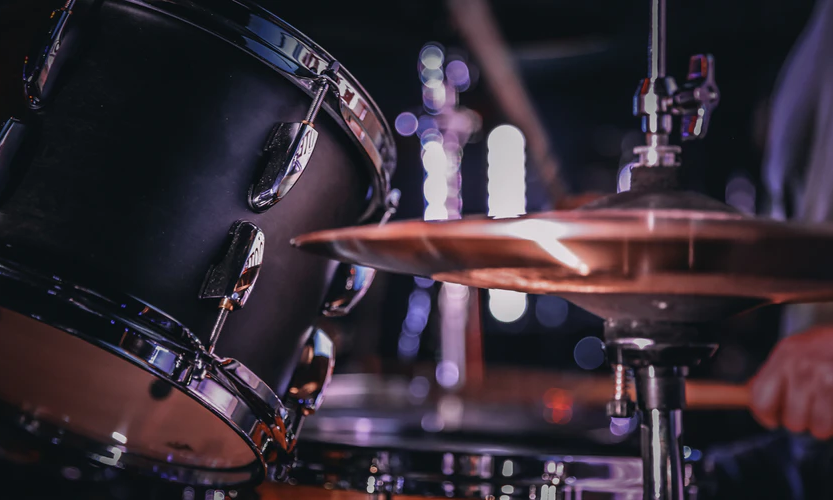
Mixing
That’s it for setup-now on to mixing where we will tailor, not create, our kit sound. As always, if you got it right in the recording, the mixing will be easy and breezy and not a time consuming chore.
If at all possible don’t mix immediately after tracking because of listening fatigue. It’s much better to come in fresh with the concept of simply getting the right sound.
I personally hate to mix after tracking. While recording I have a pure “techno Nazi” head: ears tuned for all the bad stuff, rattles, hum, clipping, pitch, meter, mistakes, etc.
While mixing, first listen with no effects, EQ, reverb, etc. Start with only the overhead pair. You should have a nice overall kit sound that’s almost usable by itself. Listen to the sound and use EQ to trim out any unneeded resonances.
Be careful not to cut into the floor toms’ fundamentals. If your board has minimal EQ, beg, borrow or steal a pair of graphics or parametrics. A single sweepable mid EQ will make life difficult here. You’ll need to EQ mids at more than one frequency.
Now’s a good time to add some reverb. You will use the drums to “trigger” the reverb and they will complement each other.
Don’t smother the drums with too much low-end EQ on either the track or the reverb. Always remember less is more!
Listen for significant tom fills and cymbal crashes. You should be able to tweak low mids and mids and separate upper mids/highs for the crash cymbals. Also cut out high-end in the reverb. We don’t want any reverb on the cymbals.
Next listen to the snare/hi-hat mic. Again, start flat. Trim the bottom for unwanted room rumblings. Work for a big snare sound, usually found in the low mids and even the upper bottom. Add the reverb and work the two.
Next, on to our optional hi-hat. Many engineer/producers make the mistake of going too high in frequency looking for a hi-hat sound. Cymbals have a broadband signal and reach well down into the mids.
Look for an effective stick and brass strike and then add highs to sweeten the sound. Not too much! Make them peek through and you’ll have the real deal.
Is the sound O.K. now? The kit should sound sort of like Levon Helm and The Band. But what if that’s not what you want? Do you need more balls, more commercial sound, more funk?
Let’s whip out the compressors. Some compression on the toms will even them out and make them cut through nicely. Again, not too much. Play with the ratio. It’s a good idea to let them build to a threshold for more dynamics. I prefer RMS compression for a more natural sound.
Snare is more critical with compression but more fun. If the drummer is consistent in volume, you can use a higher ratio, but watch the threshold. Let it limit only the top. Watch the lil’ red lights and make ‘em dance to the beat. This way you can control the ring tone of the drum and make it really funky.
This same snare technique will work fine on the kick drum. You can control the attack and tone. Watch the bottom end with the EQ. Don’t overdo it or it will get lost when heard with the bass player. Look for EQ frequencies that separate the kick from the bass.
I use little or no reverb on kick drums. You want to trigger the reverb with the compressed signal from the snare and toms to get a naturally reverberant sound. This is exactly what a properly tuned and played kit in a decent acoustic environment would sound like…….with a little help from our electro friends.
Now you should have all the control you’ll ever need. You can raise and lower kick and snare independently as needed in the mix.
You can also pan the tom-toms as you like. I usually use a medium pan on the overheads. This way when the drummer plays a fill across the kit, it will bloom across the sound field and then settle down the way a real kit would-unlike with the hard synthetic panning of individual toms that always stay separated from each other. This naturally occurring sound will also help the drummer, as his kit will sound the same in the cue ‘phones as it does live.
I usually leave the kick and snare near center, but not on top of each other. It’s best to slightly separate kick and bass. Bass that is too far to either side is bad news for the mastering engineer.
During tom fills, the effect of natural buildup is due to the toms’ resonance enhanced by the corner walls and your compressor.
Tweaks For Different Genres
Try this technique when you have time and you’re not under a deadline. It’s well worth the effort. If you can nail it, it will work with little variation on many types of music.
Some suggestions:
– R&B: Toms medium spread, kick and snare tight-panned.
– Country: Tight-panned snare and kick, medium tom spread (just like R&B).
– Jazz: Close-mike the snare and kick, mike the toms not too close, and use very little “room program” reverb.
– Doo-wop: Mike very close for mono sound, and use little or no reverb.
– Reggae: Mike snare and kick very close, pan toms wide, use tight EQ and mucho reverb.
Neat huh? Good luck!
